- Places
- Plans
- Itineraries
- Experiences
Lake Orta with Isola San Giulio.
Lake Orta is the westernmost lake in the entire region, lying entirely in Piemonte just west of Lake Maggiore.
The lake has two main sights:
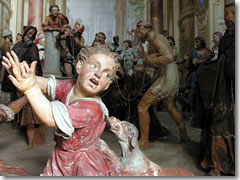
Papier-mâché figures in the Sacro Monte chapels of Lake Orta.Partway up the lake's eastern shore juts lies a wooded promontory, which was turned into one of Piemonte' famous Sacro Monte, or sacred mountain.
A "sacred mountain" usually consists of a path wining up a hillside lined by devotional chapels in the devout can stop and pray (when they're themed as the stations of the cross, it's called a Via Crucis).
In this case, the winding path is lined by 20 chapels decorated between 1591 and 1770 plus a church at the top, all of them populated by odd papier-mâché figures under riotous baroque and rococo frescoes on the walls and ceilings.
Snuggled into the lakeward side of the Sacro Monte promontory is the main town of Orta S. Giulio.
This town takes its quaintness quite seriously—they even make you park a five-minute walk from the historic center's pebble-paved paths and stone-shingled roofs.
From the main lakeside Piazza Motta, with its modest cafes and notable Palazetto della Comunità (a lovely little 16th century town hall), small boats (www.motoscafisti.com) head to the postcard Isola S. Giulio, home to a basilica founded by San Giulio himself, a saint with a quite colorful history.
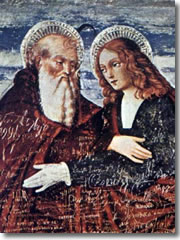
San Giulio (left).St. Giulio is what happens when you put saintly legends and pop culture into a Cuisinart and let 'er rip. He's a bit St. Patrick, a bit St. Colomba, a bit St. Francis, a bit Dirty Harry, and a bit The Beach Boys.
Giulio and his little brother Giuliano were born in the late forth century on the Aegina Islands just south of Athens, but before long they had heard their calling and made their way to Rome. From there, they waged an ecclesiastical rampage throughout Italy, razing pagan temples and building churches as they went, leaving 100 new basilicas in their wake.
In Brebbia, one of the workers building a Giulio-directed church sliced off his thumb and swooned with loss of blood. The other workers ran to Giulio and he bellowed "Bring me that thumb!" He stuck it back on, made the sign of the cross, the thumb was healed, and Giulio became the patron of masons (the guys who build walls, not the ones with lodges and secret handshakes).
Once, when a wolf slaughtered one of his oxen, Giulio simply hitched the wolf to the cart and tamed him, St. Francis-style, into being a beast of burden.
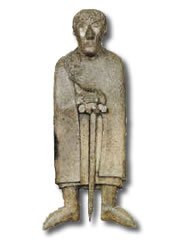
San Giulio (from a carving inside the church).Other miracles began accruing to him, and not all were of this friendly sort. As he gathered a crowd of men in Gozzano (just south of Lake Orta) to start on yet another church, a couple of guys in a cart came up the road and found it blocked by the gathering of willing workers. Not wanting to be press-ganged into service themselves, one of the lazibones lay on the cart under a sheet and the other drove through the crowd, yelling out to make way for the dead man. Giulio stopped them and asked "Why do you lie to a man of God?" and the driver protested that he wasn't lying. When he got up the road a bit, he tried to wake his friend, only to discover that his lie had become truth. Giulio had miracled the possum-player dead in a sort of brutal, Old Testament–type lesson.
While Giuliano was busy building their 99th church on the shores of Lake Maggiore, Giulio told him he was off to find the site for their 100th (he hadn't liked the looks of the Borromean Islands and wanted to find some "less evil" ones).
When Giulio got to Orta (unlike today), he found no boats willing to carry him over to the bramble-covered island in the lake, which was held to be infested by snakes and dragons—and if that was considered superior, in a good-vs-evil sense, to the Borromei, I'd hate to see what those Stresa islands looked like back in the day.
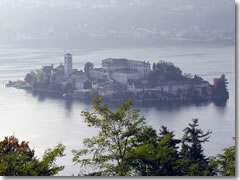
Isola San Giulio on Lake Orta.Rideless, Giulio spread his cloak out on the surface of the water, stuck his staff at its head, and the whole shebang stiffened up. He stepped onto the cloak and hang-tenned it right over to the island, where he clambered through thick thorn bushes to the island's peak, made a cross out of the thorny branches, and used it to exorcise the serpents (shades of British Isles saints such as Patrick, with the whole snake thing, and the St. Columba, who once miraculously sailed across Loch Ness to tangle with Nessie).
When Giuliano arrived, Giulio told his brother to hurry up and finish the church on the island, as he would need to use tomb for himself soon. As usual, he was not lying, and the saint is now buried in the church. Giulio appears inside carved in dark stone twice: leaning on his sword between Evangelists on the wonderful Romanesque pulpit, and battling mythological beats on a wall relief. The frescoes on the right aisle are 14th and 16th century.
(While Giulio may very well have built a church here, and his story is pretty gnarly in of itself, the true history of the island is far bloodier. Onorato, the Bishop of Novara, first started fortifying the island basilica in 489, and it became the site of bloody Dark Ages battles waged between, in various combinations, the prince-bishops of Novara, Lombard kings, Charlemagne's troops, Holy Roman Emperors, self-styled Kings of Italy, and countless local dukes and counts. By the end of the first millennium, it had resisted numerous sieges and changed hands nearly a dozen times.)
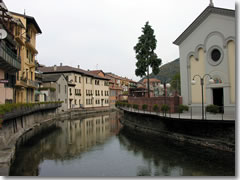
Omegna on Lake Orta.Some bemoan that Italy lost its centuries-long lead in artistic innovation after the French came up with Impressionism. But Italy really just switched artistic gears from painting and sculpture to the cinema (think: Fellini), the automotive industry (Ferrari, Maserati, Lamborghini, Alfa Romeo), and industrial design.
Italy is a culture that celebrates la dolce vita, the art of living well, and its industrial designers are maestros at turning everyday objects such as teakettles, lighting systems, juicers, and even pens into art objects worthy of a museum. These often whimsical, usually beautiful, and always ergonomically sound results are on sale throughout Italy, or you can go right to the source on Lake Orta.
At the north end of the lake, the town of Omegna and its suburb of Crusinallo are the unlikely epicenter of Italian industrial design, where an artisan tradition gave rise in the late 19th century to firms that developed into the modern giants of housewares: Alessi, Calderoni, Lagostina, and Bialetti—the firm where it really all started in 1933 with the arrival of the famous octagonal-hourglass Moka Express stovetop espresso maker, which is still a mainstay in every Italian home and now comes in many mod varieties.
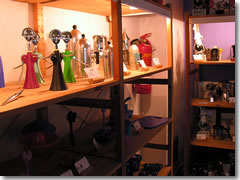
The designer housewares shop at the Forum Museum of Omegna, Lake OrtaIn the town's industrial suburbs there's a Forum Museum (www.forumomegna.org) of this modern utilitarian art form, including groundbreaking designs by Richard Sapper, Philippe Starck, and Robert Graves. They also have a fantastic gift shop: the best of Italian design gathered in one spot.
By the way, if you're really into this, there are factory outlet stores all along Via IV Novembre, offering 30 to 50% off last year's models (slight irregulars can be even cheaper). There's a Lagostina outlet at no. 39, a Bialetti one at no. 106, Fratelli Piazza Effepi at no. 242, and Alessi on Via Privata Alessi.
For more info:
www.distrettolaghi.it
Also useful:
www.comune.ortasangiulio.no.it
www.orta.net
Hotels on Lake Orta - Orta Sun Giulio
Hotel Villa Crespi [€€€] - My favorite hotel on the lake is a 19th century Moorish fantasy castle with a wonderfully over-the-top Arabian Nights style, sumptuous appointments, and a restaurant that has garnered two Michelin stars. » book
If you don't have a rental car, the easiest way is by train, usually via a transfer in Novara (Omegna is 2–3 hrs. from Milan or Turin). Form Omegna you have to catch a bus down to Orta S. Giulio (3 per day; 35–55 min.).
To get from Lake Maggiore to Orta, the best bet is a bus: twice daily from Stresa to Orta S. Giulio and Omegna (tel. +39-0323-552-172, www.safduemila.com), and 4–5 daily from Arona to Omegna (75 min.; tel. +39-0322-846-465, www.comazzibus.com)—also to Orta S. Giulio, but only once a day at 10am and with a change at Borgomanero (nearly 2 hrs.).
You really need your own car.
Share this page
Search ReidsItaly.com
For more info:
www.distrettolaghi.it
Also useful:
www.comune.ortasangiulio.no.it
www.orta.net
Hotels on Lake Orta - Orta Sun Giulio
Hotel Villa Crespi [€€€] - My favorite hotel on the lake is a 19th century Moorish fantasy castle with a wonderfully over-the-top Arabian Nights style, sumptuous appointments, and a restaurant that has garnered two Michelin stars. » book